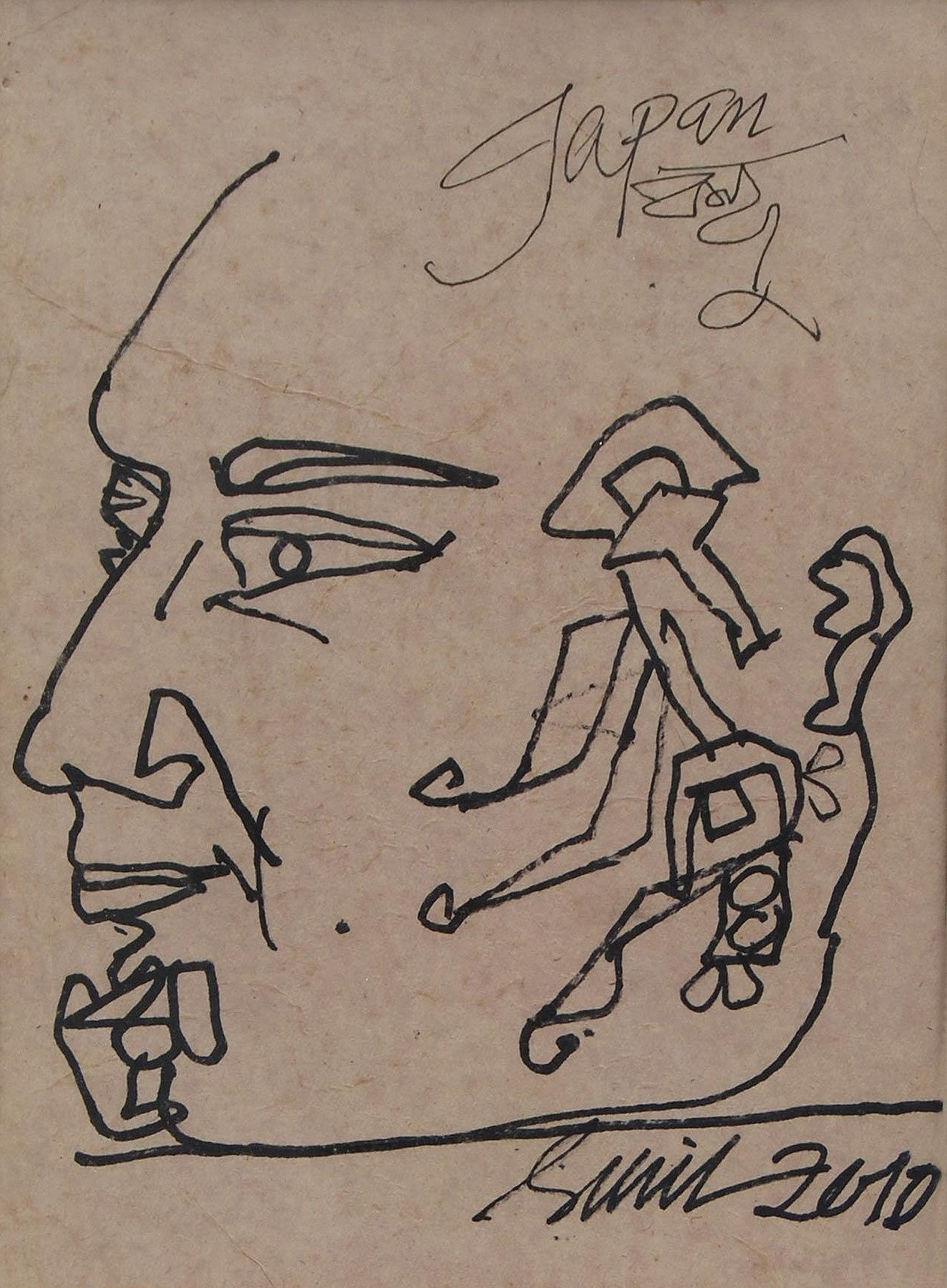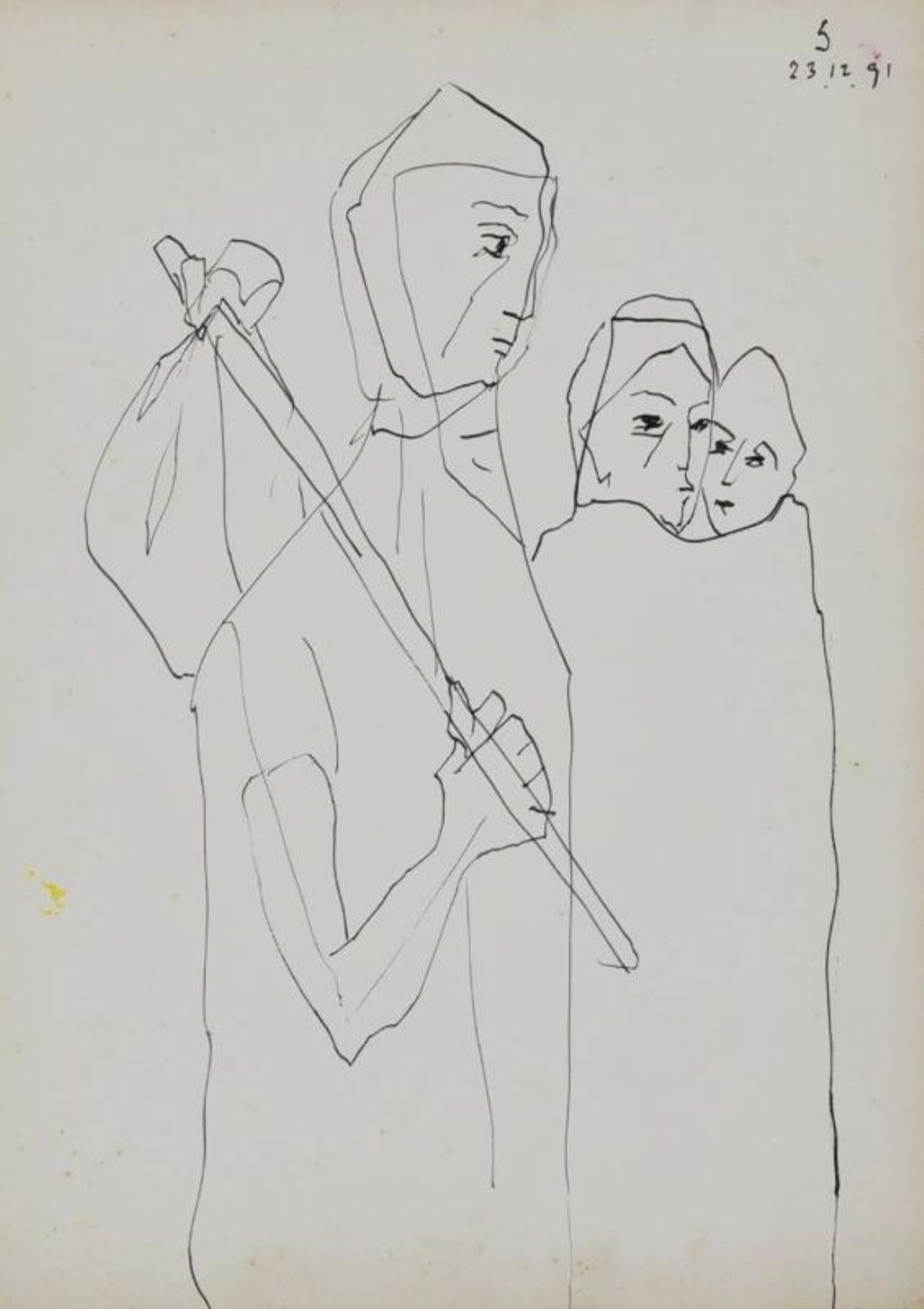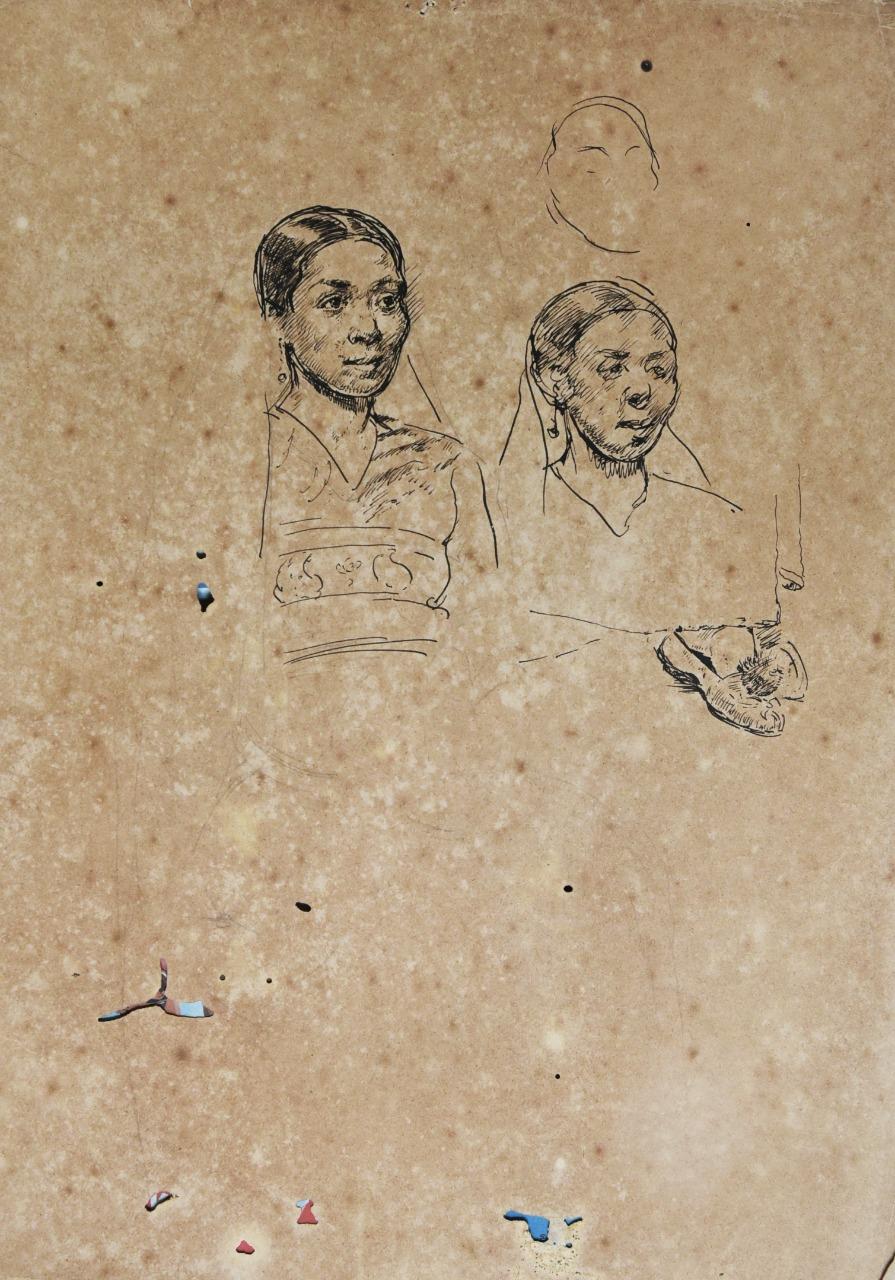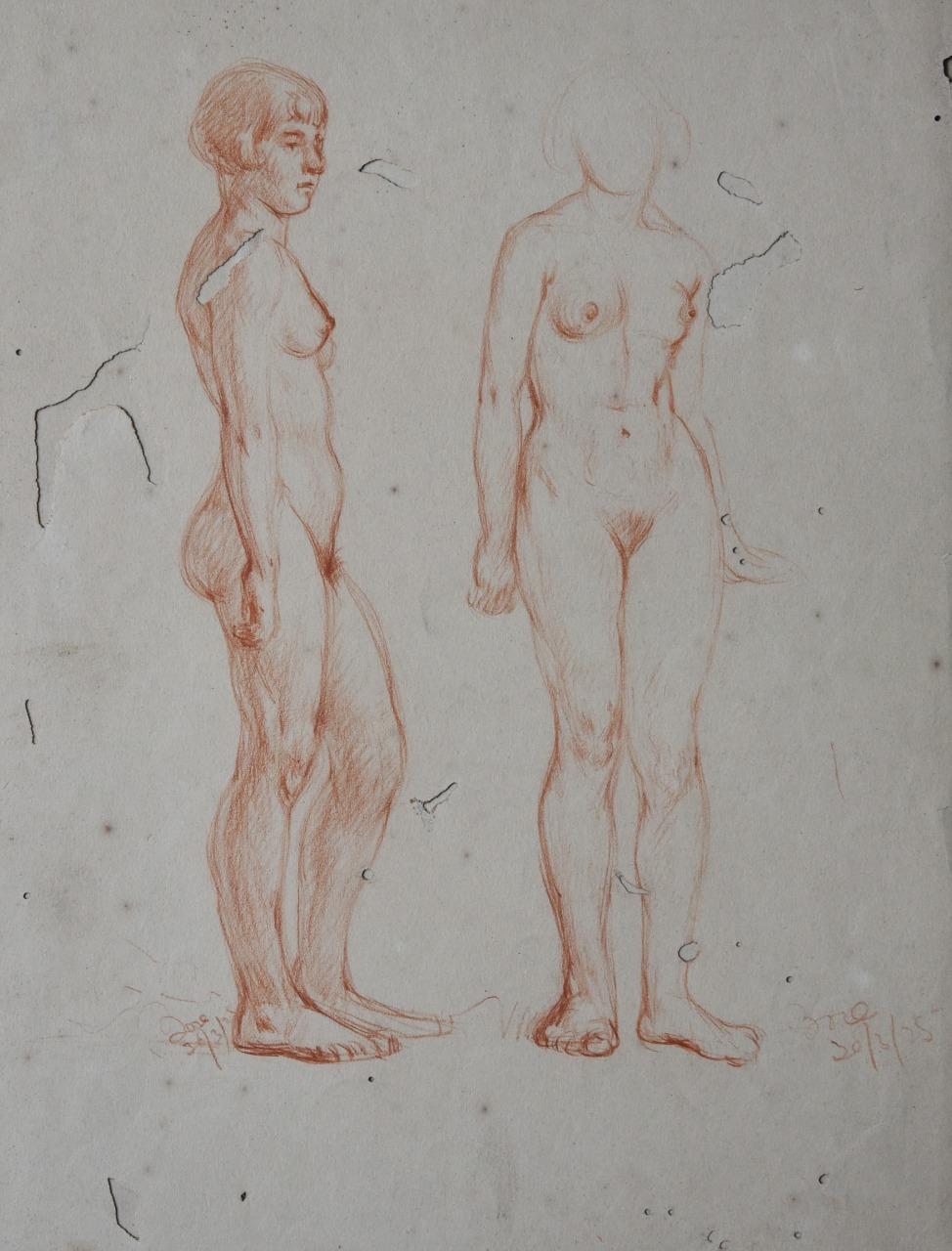Items Similar to Drawing, Black-White, Hindu Goddess Kali, Pen, Ink, Modern Indian Art "In Stock"
Want more images or videos?
Request additional images or videos from the seller
1 of 9
Prakash KarmarkarDrawing, Black-White, Hindu Goddess Kali, Pen, Ink, Modern Indian Art "In Stock"2005
2005
About the Item
Prakash Karmakar – Kali – 16 x 11 inches (unframed size)
Ink on paper
Inclusive of shipment in roll form.
Kali is the Hindu goddess (or Devi) of the destroyer of Evil. Also considered a strong mother-figure and symbolic of motherly-love , Goddess Kali is Worshipped Widely in the State of Bengal. Modern Indian artists and Contemporary Artists both have captured the Essence and the Strength of the Goddess Kali in their works. Consort to Shiva she was the unconventional powerful woman who broke all conventions, Destroyed all evil and wore a dangerous expression on hern face. She even stood on the chest of Lord Shiva , her husband.
Here this lovely Drawing in Black and White , Ink on Paper is a typical rendition of the Goddess seen in all her power and might . She has four hands and wears a garland of heads.
Style : Legendary master artist Lt. Prokash Karmakar from Bengal was solely responsible for the Bengal Movement of Art. His father Lt. Prahalad Karmakar was a very famous legendary artist ; but unfortunately all his paintings got burned in the riot. Prokash Karmakar led a very tough life , ofthen sleeping on the platforms of the railway stations of Bengal. Later he worked in the textile line and simultaneously painted and exhibited his works on his own strength , until he got huge acclaim and success .
He was a master nude artist and painted women in their natural habitat. In his earlier days of artistic practice the Master Painter along with his contemporaries exhibited on street corners , to shun the four walls of the gallery .
Most of his earlier artworks capture remembrances from the past - some of them are very personal, and some are from the darkest moments of human history. More recently he has painted landscapes, depicting lush tropical vegetation, hills and valleys, seascapes and mangroves in their wild diversity.
Large fish-shaped eyes are assets of Prokash Karmakar females by which he is often recalled. More so because his female are rendered askew with voluptuous curves, drunken stare and sometimes wantonly explicit erotic gestures. At one time, quite early in his life his demonic damsels, fem mes’ fa tales, or nudes with fleshy shapes of sensual bulge or dismembered limbs or focused genitalia became his signature images. His landscapes too with their piquant painterly refashioning of natural forms and by sheer force of their varied recurrence became a subject-index of his style.
About the Artist and his work :
Born : 20th October, 1933.
Education :
Govt. college of Art & craft, Kolkata
Prokash Karmakar came from an artistic family; his father was a renowned artist of his time.
Unfortunately, all of his father's paintings were destroyed in the Hindu Muslim riots in the 1940s, which also ruined his family.
By 1949, both his parents had passed away, forcing him to abandon his studies at the Government College of Arts and Crafts, Kolkata.
He joined the army for two years and then quit to work as a graphic design manager for a medical firm in Kolkata.
Virtually penniless and desperate for a break, in 1956, he held a street exhibition, the first in the city, hanging his works along a corner.
Selected Exhibitions :
2008 - 'Hues of Bengal',Janues Art Gallery
2008 - 'Art from Bengal',Art Elements Gallery,New Delhi
2008 - ‘The Artecurate ‘, Mumbai Art Festival.
2007 - 'Signatures Images',Gallery Kolkata,Kolkata
2007 - ‘Uninterrupted Journeys’, Nitanjali Art Gallery,New Delhi
2007 - ‘Tales of Textures’, Art Elements Gallery,New Delhi
2006 - ‘Drawing show an act of Art –II’,Priyasri Art Gallery,Mumbai
2006 - 'Frames & Beyond',Neheru Center,Mumbai
1968-65-67 - National Art Exhibition, at Lalit Kala Academy, New Delhi
Awards :
2000 - He was a recipient of Abinendra Puraskar Award
1976 - Awards from Biria Academy of Art and Culture, Kolkata
1970 - Rabindra Bharati University, Kolkata.
1969-70 - Fellowship for Study in France.
- Creator:Prakash Karmarkar (1933, Indian)
- Creation Year:2005
- Dimensions:Height: 16 in (40.64 cm)Width: 11 in (27.94 cm)Depth: 1 in (2.54 cm)
- Medium:
- Movement & Style:
- Period:
- Condition:
- Gallery Location:Kolkata, IN
- Reference Number:1stDibs: LU60433473822
About the Seller
4.9
Vetted Seller
These experienced sellers undergo a comprehensive evaluation by our team of in-house experts.
Established in 2004
1stDibs seller since 2017
118 sales on 1stDibs
Typical response time: 18 hours
- ShippingRetrieving quote...Ships From: Kolkata, India
- Return PolicyA return for this item may be initiated within 7 days of delivery.
More From This SellerView All
- Head, Japan Bandhu, Ink on Paper, Black, Brown by Indian Artist "In Stock"By Sunil DasLocated in Kolkata, West BengalSunil Das - Head - 9.25 x 7 inches (unframed size) Ink on Paper Inclusive of shipment in ready to hang form. Sunil Das (1939-2015) was a Master Modern Indian Artist from Bengal. Ext...Category
2010s Modern Figurative Paintings
MaterialsInk, Paper
- Untitled, Mixed Media on Paper, Black, Yellow colour by Modern Artist "In Stock"By Sakti BurmanLocated in Kolkata, West BengalSakti Burman (a) Untitled - 3 x 6 inches (Unframed size) Pen on Paper , 1992 (b) Untitled - 4.5 x 9 inches (Unframed size) Mixed Media on Paper , 1992 Framed & Door Deliver...Category
21st Century and Contemporary Modern Figurative Paintings
MaterialsInk, Paper, Mixed Media, Pen
- Fairy & Woman, Drawing, Ink on paper by Modern Indian Artist "In Stock"By Badri NarayanLocated in Kolkata, West BengalBadri Narayan - Untitled - 11 x 15 inches ( unframed size) Ink on paper Inclusive of shipment in ready to hang form. Style : The artist’s paintings are narrative, and titles like ‘Q...Category
21st Century and Contemporary Modern Figurative Drawings and Watercolors
MaterialsInk, Paper
- Family, Pen & Ink on Paper by Modern Indian Artist Somnath Hore "In Stock"By Somnath HoreLocated in Kolkata, West BengalSomnath Hore - Family Pen & Ink on Paper, 13.6 x 10 inches ; 1991 ( Unframed & Delivered ) Inclusive of shipment mounted not framed, Should you wish to receive the same framed and s...Category
1960s Modern Figurative Drawings and Watercolors
MaterialsInk, Paper
- Royal Academy Series-3, Pen & Ink on Paper, Modern Artist Atul Bose "In Stock"Located in Kolkata, West BengalAtul Bose - Royal Academy Series-3 Pen & Ink on Paper, 15 x 11.2 inches (Unframed Size) 1924-26 (Delivered Unframed in as is condition) Atul Bose was a master artist whose creative journey spanned several decades and left an indelible mark on the Indian art scene. He was born in 1898 in a small village in Bengal and showed an early aptitude for art. Despite facing financial difficulties, he pursued his passion and enrolled in the Government School of Art in Calcutta. Bose's early works were influenced by the Bengal School of Art, which was a movement that sought to revive traditional Indian art forms. However, over time, Bose developed his own unique style that blended elements of Indian art with European modernism. He was particularly influenced by the works of artists like Paul Cezanne and Georges Braque. Bose spent two years, 1924-6, at the Royal Academy. He was heavily influenced there by the post-impressionist Walter Sickert. He refused an invitation to help decorate the pavilion at the British Empire Exhibition in 1924 with Mukul Dey...Category
1920s Modern Figurative Drawings and Watercolors
MaterialsInk, Paper, Pen
- Royal Academy Series-4, Conte on Paper, Modern Artist Atul Bose "In Stock"Located in Kolkata, West BengalAtul Bose - Royal Academy Series-4 Conte on Paper, 15 x 11.2 inches (Unframed Size) 1924-26 (Delivered Unframed in as is condition) Atul Bose was a master artist whose creative journey spanned several decades and left an indelible mark on the Indian art scene. He was born in 1898 in a small village in Bengal and showed an early aptitude for art. Despite facing financial difficulties, he pursued his passion and enrolled in the Government School of Art in Calcutta. Bose's early works were influenced by the Bengal School of Art, which was a movement that sought to revive traditional Indian art forms. However, over time, Bose developed his own unique style that blended elements of Indian art with European modernism. He was particularly influenced by the works of artists like Paul Cezanne and Georges Braque. Bose spent two years, 1924-6, at the Royal Academy. He was heavily influenced there by the post-impressionist Walter Sickert. He refused an invitation to help decorate the pavilion at the British Empire Exhibition in 1924 with Mukul Dey...Category
1920s Modern Figurative Drawings and Watercolors
MaterialsInk, Conté, Paper, Pen
You May Also Like
- Americana Farmer and Wife, Gouache Painting WPA Art William Gropper WoodchopperBy William GropperLocated in Surfside, FLWilliam Gropper Original Gouache on Paper depicting man carrying an axe and woman carrying basket walking together. Hand signed lower right Fra...Category
Mid-20th Century Modern Figurative Paintings
MaterialsInk, Watercolor, Gouache
- Americana, Lawyer in Court, Politician, Gouache Painting WPA Art William GropperBy William GropperLocated in Surfside, FLWilliam Gropper Original Gouache on Paper Hand signed lower right 33.5 x 27.5 image 26 x 20.5 The New-York born artist William Gropper was a painter and cartoonist who, with caricature style, focused on social concerns, and was actively engaged in support of the organized labor movement throughout his career. This original watercolor drawing is done in the iconic style of the artist's oeuvre. Born to Harry and Jenny Gropper in 1897, William was raised in New York City's Lower East Side. His parents were Jewish immigrants from Romania and Ukraine, and young William grew up in relative poverty, watching his family struggle to achieve that sought-after American dream. His father, a bright and college-educated man, was unable to find employment that worthy of his intellect. His mother, meanwhile, worked as a seamstress from home. Coupled with the devastating loss of an aunt to the infamous Triangle Factory fire of 1911, significant childhood factors created the foundation that led to Gropper’s exploration of the American experience. Early on, Gropper displayed an extraordinary, natural skill for art. By 1912, he was already studying under the instruction of George Bellows and Robert Henri at the Ferrer School in Greenwich Village. During his time at school, Gropper was also awarded a prestigious scholarship to study at the National Academy of Design. However, he refused to fit into convention and was swiftly expelled from the Academy. After his expulsion, Gropper returned home to help financially by assisting his mother and taking a shop position. However, he didn't abandon art academia and soon presented a portfolio to the New York School of Fine Art which earned him a scholarship for study. Gropper obtained his first significant job as a cartoonist for the New York Tribune in 1917. While working as a staff cartoonist for the Tribune, he also contributed drawings to publications like Vanity Fair, New Masses, The Nation, and Freiheit. His interest in the welfare of the American worker, class inequality, and social injustice was central in his work. After publishing the graphic novel Alley Oop in 1930, Gropper's illustration career extended well into the decade. However, he was never exempt from controversy, and his 1935 Vanity Fair cartoon; prompted anger from the Japanese government. As an involved labor organizer and Social Realist activist, Gropper continued to bring attention to his radical reputation with visits to the Soviet Union and Poland. However, his concern with European politics and U.S. social causes didn't slow down his artistic career, and by the late 1930s, he had produced significant murals for American cities like Washington D.C. His 1938 mural Construction of a Dam was commissioned for the Department of the Interior and represents the Social-Realism style that depicts experiences of the worker and everyday societal life. Measuring at a staggering 27ft by 87ft, the piece portrays muscular, robust American laborers scaling rocky hillsides, building infrastructure, and operating heavy machinery. The mural feels undeniably American with golden scenery, denim blues, and steely gray colors. Gropper fits perfectly into Social-Realism because the style exhibits an illustrative flair with strong lines and simple, bold hues. The inspiration for Construction of a Dam sprang from his 1937 travels to the poverty-stricken Dust Bowl area. The trip was sponsored by a Guggenheim Foundation Fellowship, and his drawings of the Grand Coulee and Boulder Dams...Category
Mid-20th Century Modern Figurative Paintings
MaterialsInk, Watercolor, Gouache
- "Men at the Seattle Public Market" (Two Figures)By Mark TobeyLocated in Missouri, MOMark Tobey "Men at the Seattle Public Market" (Two Figures) 1958 Ink and Tempera on Silk Signed and Dated Lower Left *This is a rare and important work. See attached images with book...Category
Mid-20th Century Modern Figurative Paintings
MaterialsInk, Tempera, Silk
- Scroll painting of the American ship commanded by Commodore Matthew PerryLocated in Amsterdam, NLAttributed to Ukita Ikkei (1795-1859) Hanging scroll painting of the American ship commanded by Commodore Matthew Perry in Uraga Bay, annotate...Category
Mid-19th Century Edo Figurative Drawings and Watercolors
MaterialsInk, Paper
- Yangliuqing Longevity New Year Painting, c. 1920Located in Chicago, ILChinese New Year paintings (nian hua) are colorful folk paintings created to celebrate the annual Spring Festival. Drawn or printed by folk artists in regional studios, nian hua pain...Category
Early 20th Century Folk Art Figurative Paintings
MaterialsInk, Pigment, Paper
- Yangliuqing Peace & Prosperity New Year Painting, c. 1920Located in Chicago, ILChinese New Year paintings (nian hua) are colorful folk paintings created to celebrate the annual Spring Festival. Drawn or printed by folk artists in regional studios, nian hua paintings featured exaggerated characters with bright and contrasting colors. Put up around the home to beckon luck and happiness in the coming year, most paintings depicted mythical guardians, scenes from folk operas, or auspicious symbols of good luck. This New Year painting depicts a young woman holding a vase filled with peony blossoms. This combination of motifs is a visual idiom for "may you have peace and prosperity" (ping'an fu gui). The early 20th century painting is from the town of Yangliuqing, one of the leading producers of traditional New Year's paintings known for its combination of woodblock printing...Category
Early 20th Century Folk Art Figurative Paintings
MaterialsPaper, Ink, Pigment
Recently Viewed
View AllMore Ways To Browse
Indian Art
Master Ink Art
Modern Indian Art
Large Figure Drawings
Large Modern Graphic Art
Large Line Drawing Painting
Black And White Large Modern Painting
Black White Line Drawings
Black And White Line Drawing
Black And White Line Drawings
1940s French Drawings
Hills And Valley
Habitat Modern
Hindu Art
French Medical Art
Medical Drawing
Black And White Modern Large Drawings
Large Pen And Ink





